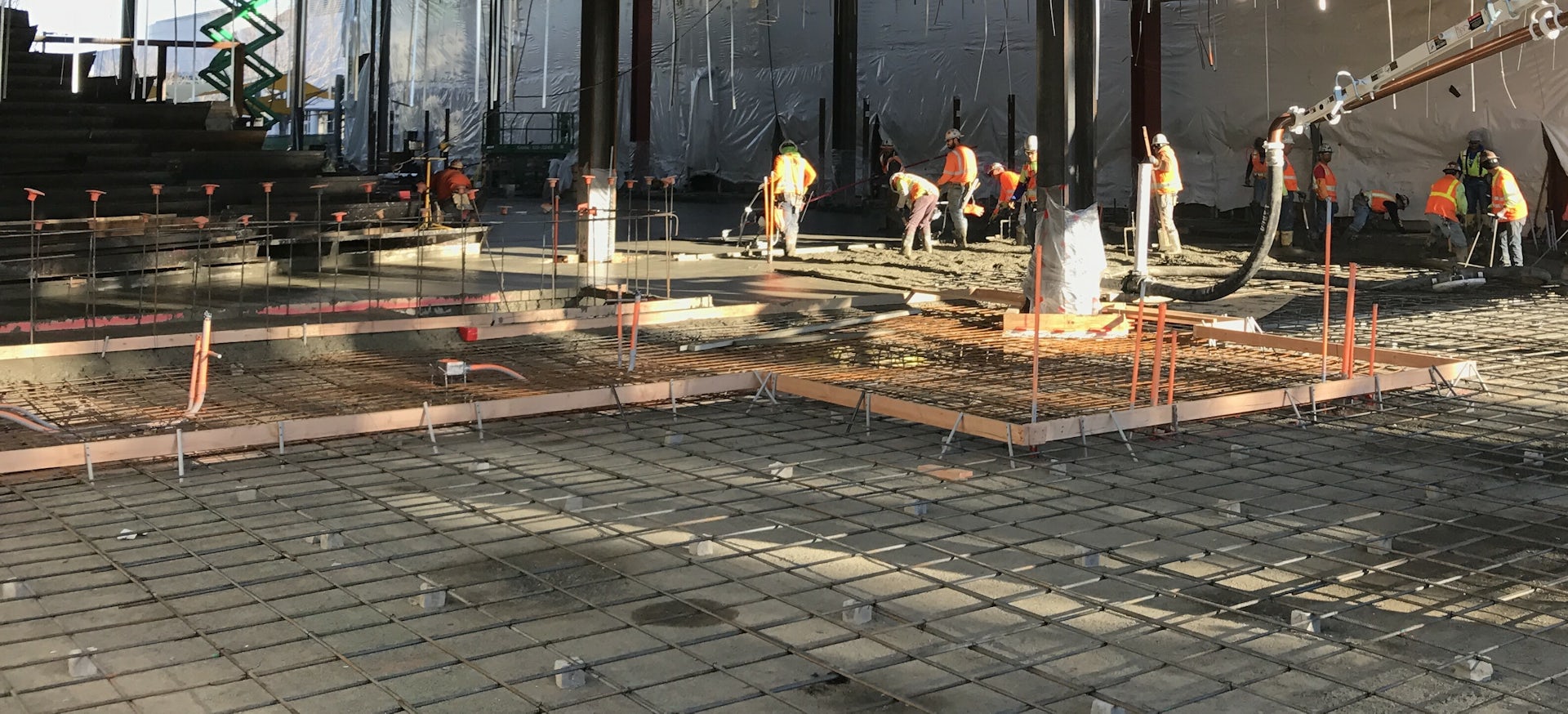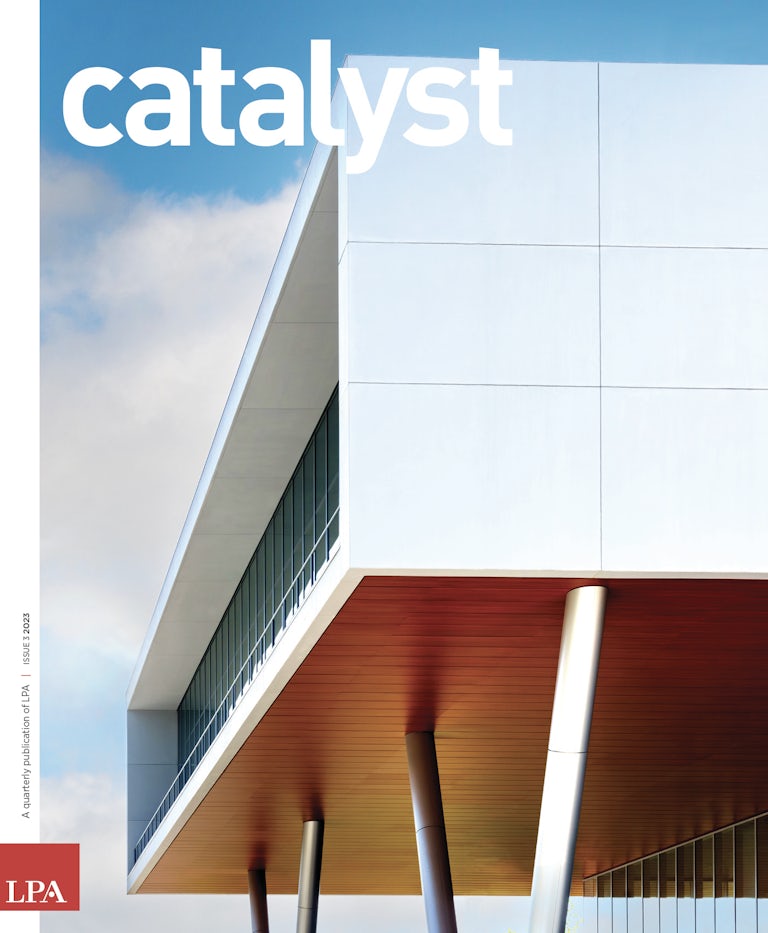By John Hoenig, PE
Managing Director of Structural Engineering
Soil prone to expansion or shrinkage due to variation in water volume is a common challenge for building owners in select locations throughout the United States, especially in southern and western states. Buildings on expansive soil come with risk of structural damage over time due to changes in the soil moisture levels. Structural designers have many strategies to mitigate these risks, but too often, they default to strategies that cost more, require more maintenance, and limit future flexibility. These outcomes can be avoided with a multi-discipline design approach that considers a broader range of factors.
Re-evaluating Slab-on-Grade Construction in Expansive Soils: An Integrated Design Approach
A multidiscipline approach to ground floor structures can find solutions that lower up-front and long-term costs and manage risks from soil movement.

Ground floor structures typically use one of three options: a concrete slab-on-grade, a structured concrete slab over void forms, and a structured slab over a crawlspace. These systems vary in their cost, risk of damage due to shifting soil, time to construct, future flexibility, maintenance and embodied carbon performance (Figure 1). Slab-on-grade is an inexpensive solution that is often perceived to have a higher risk of movement and wall cracking compared to more expensive designs. Too often, it is evaluated based solely on these factors without a more thoughtful consideration of movement prevention strategies. This two-dimensional decision limits the owner’s ability to make the best decision for their project.
This missed opportunity is the result of a traditional design process where design disciplines are siloed. Typically, the owner pays for a geotechnical report, the design team passes it on to the structural engineer, and the structural engineer is the only one who implements the recommendations. A better process, using integrated design, starts with a thorough assessment involving geotechnical, structural, civil, landscape, plumbing and architecture disciplines. By including all these design disciplines on the team from the beginning of the project, owners can balance initial cost and soil movement risk with other factors that impact the larger goals of the project.
In many cases, contrary to the conventional wisdom, slab-on-grade is the best choice. Slab-on-grade options can cut construction costs, leaving more money for program space and other project priorities. The risk to soil movement is real; however, it can be managed with a multidiscipline approach to reduce risk and realize the cost savings of the slab-on-grade design. This can result in a more cost-effective building that can be built faster, remains flexible for the future, costs less to modify, is easier to maintain and emits less greenhouse gas, while still mitigating the risk of damage due to changes in soil moisture.
To understand the potential solutions in expansive soil conditions, we must first understand the causes of soil-induced slab movements, the nature of expansive soils, and what causes them to change volume. Expansive soils are clay soils that expand in volume when exposed to moisture. The force associated with this expansion is enough to cause significant damage to building finishes, site pavement, ground floor slabs and building foundations supported by the expansive soil. The expansion potential is measured in terms of the potential vertical rise (PVR), which quantifies the potential of soil to swell under typical loading conditions when exposed to surface water. If additional water is introduced to the soil, the actual expansion can exceed the calculated PVR for the soil.

When a geotechnical engineer recommends slab-on-grade, one of two approaches is typically employed for PVR mitigation. One method is moisture conditioning of the existing expansive clay soils and adding a thin (1-foot) cap layer of select fill under the building. This method of PVR mitigation relies on the on-site expansive soils being placed in a wet, “pre-swelled” condition with the “cap” layer preventing future moisture loss, thus maintaining a stable soil volume. The moisture conditioning is often extended five to 10 feet beyond the building perimeter and covered with a clay cap or site paving to prevent surface water accumulation in the soil under the building (Figure 2). The second most common option is to replace a portion of the expansive soils with non-expansive select fill for a depth determined by the geotechnical engineer. In each of these strategies, if the soil under the select fill changes moisture content more than anticipated by the geotechnical engineer, soil movement will occur and can result in damage.

Strategic sub-grade preparation is only the first step to good slab-on-grade performance. Slab-on-grade floor systems start to fail when moisture is either added to or removed from the subgrade preparation over the life of the building. Potential causes for excessive water accumulation in the subgrade include roof downspouts discharging at grade, poor site drainage at building perimeters, broken sanitary sewer pipes or pipe bedding being allowed to penetrate a building perimeter, allowing surface water or irrigation leaks to transmit deep into the building (Figure 3). The supersaturated soil under the building causes heaving of the slab approximately three to six feet from the perimeter wall.

To minimize the amount of water accumulation in the soil under the building slab, storm drains should be either captured below grade in storm sewers or discharged onto paving that is positively flowing away from the building. All plumbing lines should have a clay plug at the building perimeter to prevent surface water or irrigation water from entering the building through granular pipe bedding. This requires early coordination with civil and plumbing engineers.
Drying of the soil under the building over its lifespan is equally problematic. While the building slab and vapor retarder prevent moisture escaping from above, if the exterior of the building is allowed to become sufficiently dry in the summer, moisture can be lost under the building perimeter due to capillary action (Figure 4). Capillary drying is a mechanism where moisture in soils far from the building perimeter are sucked outward through hydrostatic forces, which results in a settling slab approximately five feet inside the exterior building wall. Adding a moisture barrier around the perimeter moves the capillary drying zone outside the building footprint, leaving the moisture content under the slab seasonally stable. This requires coordination with the architect and landscape architects.

Another common cause of slab settlement is moisture loss due to the presence of large trees near the building. It is common for mature tree roots to extend up to 40 times their trunk diameter or two to three times the canopy diameter. Tree roots can cause slab settlement 40 to 50 feet inside the perimeter of a building. The obvious engineering solution is to not plant trees close to the building. However, the location of trees is not solely an engineering question. When the project calls for trees to be planted near buildings, installing a root barrier (Figure 5) and moisture barrier can prevent the tree roots from penetrating the building perimeter and drawing the water out of the moisture-conditioned building subgrade. This requires collaboration with the landscape design.
In areas of expansive soils, owners often spend more money on ground-floor construction than needed. A multidisciplinary approach to a slab-on-grade can save the owner money while providing a high-performing, low-maintenance, and highly adaptable foundation for a lower cost. It all comes down to the composition and behavior of the design team. When the different engineering, architecture and landscape design teams work in silos, there is little opportunity for the type of collaboration and coordination required to adequately address all the concerns. But in a multi-disciplinary team, where structural engineering is integrated into the process from the very beginning, these conversations are continuous, allowing owners to take full advantage of the opportunities for more cost-effective, more strategic decisions.















